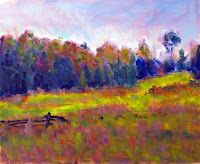This barn lost most of its west wall during a storm in late winter 2009. It is ready to go. Painting a structure that disappears from the landscape and memory shortly after is a satisfying activity for an artist. This year the barn is surrounded by wheat. Last year it was canola. It has gained significant character. Painting it will provide a painting for the archives to be shown one day as a memory amongst a series of memories.

For this paint out we attracted 5 artists and one who desperately wishes to paint this subject. You'll have to wait for another day Bob. We were fortunate that the wheat has not been harvested. In addition, we had a fabulous day for painting - 20C, low humidity, sun and cloud with a breeze, and not many bugs. Here we see David right into it, working with watercolours and a big brush.
Everyone sees the subject differently. Some establish the darks and hold 'em, others loose 'em. Some experiment, some record their feelings. Everyone has a smile. Jokes and friendly insults float about. Some ignore the patter as they get to that other place. Finally we break for lunch. Some will add work in the studio. It is so different working from life.

Hockley History, 11x14, Oil on canvas
Done with 2 #6 bristle filberts and a #8 bristle filbert. Paint on the palette was Cerulean Blue, Viridian, Cadmium Lemon Yellow, Cadmium Yellow Middle, Cadmium Orange, Alizarin, and Titanium White.
Looking at the painting here the rendition of the wheat near the barn appears too yellow. Wheat is a grayed version of orange. What do you think? More work for the studio?









